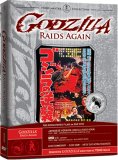Godzilla and Anguirus are discovered duking it out on a deserted island by two pilots working for a fishing fleet. Before long, the brawl makes its way to Osaka, devastating the city.
And that, as they say, is just about that, as far as plot goes. There’s a fair bit of business about our heroes’ friendship, and references to their private lives, but nothing that really has much of an impact on the plot, which remains one of the most basic in the entire Godzilla series. Lacking all of the first film’s tragic grandeur and emotional punch, this film stands or falls on the strength of the monster scenes, and these, it must be said, are pretty damn good. The fight in Osaka is especially satisfying, and there is none of the horsing around that would show up in the later movies. The climax is overlong and rather static, a real disappointment after the spectacular second act. Still and all, for too long the film has been available only in the butchered US version, and on an VHS recorded in LP mode, so for Godzilla fans, this is an exciting release.
Audio
The sound is mono, and it is showing its age. The score has some noticeable distortion. The dialogue, though, is clear, and the volume level is absolutely deafening, so the explosions and roars are suitably dramatic, even without the benefit of stereo. So all things considered, not a half bad job.
Video
The print, too, has clearly aged. Grain and guitar strings are present to varying degrees throughout, though the black-and-white tones are very nice and never murky, and the image is sharp. The biggest problem crops up about 64 minutes in on the Japanese version of the film, and lasts for the next several minutes: some truly appalling aliasing, which really starts to interfere with the viewing enjoyment.
Special Features
Both the original Japanese version and the heavily re-edited American version of the film are present. Godzilla expert Steve Ryfle provides an enormously entertaining commentary on the latter, debunking many a myth and rightfully having a fine old time at the expense of the ridiculous changes that were wrought upon the Japanese film. “The Art of Suit Acting” is a nifty little featurette that is both a biography of the main suit actors to have played Japanese monsters, but also provides a good look at what acting in 200-pound suits involved. The other extra is a poster slide show.
Closing Thoughts
There are a few hitches – the aliasing problem mentioned above, and the subtitles are sometimes a bit wonky (typos, odd turns of phrase, and the letters “l” and “o” invariably appearing so close together they look like “b”). But having said that, this remains an important, essential release.




